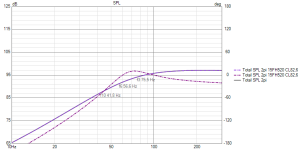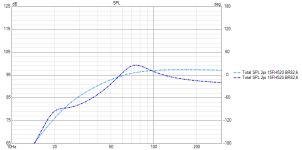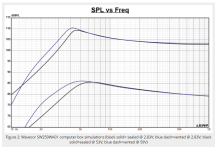After closer examinationwell ... I was just doing something very similar! 😊
here are my graphs, recorded with my current investigation loudspeaker, as shown here.
I used two sine burst signals at 50 Hz (bass reflex tuning frequency of my speaker), one with short fade-in and fade out cycles and one with hard start and stop (of course this includes high frequency contents, but the midwoofer has quite some frequency extension).
bass reflex measurement with faded-in and out 50 Hz sine burst:
View attachment 1310673
To give another interpretation I see a driver to port delay of about 5 ms. Maybe @stv can comment on how much of that is propagation delay from the distance between driver and port exit?
It's also very interesting to see the strong phase shift even on the sealed enclosure.
Last edited:
Oh we are talking about that kind of distortion levels.Err, I don't follow you. If a LF speaker distorts 10% H2 at 30Hz, the percepted H2 is only 5dB under the base frequency. If the H3 would be 10%, it actually would be louder than the 30Hz. But you know that. It actually is a well-used phenomenon in small speaker design. There seems to be bass, but there isn't. 🤣
No I was just talking about distortion in general for lower frequencies.
Btw, just for fun simulate what 82% in BL shift (= 10% distortion) does to the system response 😉
If you're at it, take a look at 70% BL as well.
Infinite Impulse Response filters are feedback filters. They take their own output and recycle it, much like a reverb. The resulting summation of the stacked signals causes the amplitude and phase to change. This is also the reason they are computationally less intensive than Finite Impulse Response filters which must store the entire period the filter is 'active' for in memory before spitting out the answer. This is the reason FIR filters tend to cause a much larger delay in the processing chain.What mechanism in EQ-ing a sealed enclosure causes it to mimic the stored energy of a ported speaker's Helmholtz resonator, and consequential long decay times to a step response.
That's because it's a highpass system, therefor the phase MUST shift.It's also very interesting to see the strong phase shift even on the sealed enclosure.
Doesn't psychoacoustics say that 2nd order distortion is masked by the fundamental? (Unless the distortion is almost as loud as the fundamental?) And most low frequency distortion is 2nd order. You don't have to agree, but I believe this is where the idea comes from.Distortion at lower frequencies is actually very difficult to hear?
"Ported extends low end response" is IMO wrong statement. It gives higher spl above tuning F, but below tuning spl drops down faster. Then add port resonances etc. nonlinearities as extra problems that don't appear on simulations.
This is silly. Given a suitable driver, porting absolutely does allow a speaker to maintain a flat frequency response curve down to a lower frequency than a sealed woofer is capable of, all things being equal. (All things being equal means no tricks like DSP...) Porting is a trade off, so I told the guy to use a ported design only if he needs to. If he can make it work without a port, that's better.
Yes, more-or-less.Doesn't psychoacoustics say that 2nd order distortion is masked by the fundamental? (Unless the distortion is almost as loud as the fundamental?) And most low frequency distortion is 2nd order. You don't have to agree, but I believe this is where the idea comes from.
Except, most low frequency is certainly not always 2nd order distortion.
This really depends on many things, one of the examples is if the motor is overhung, underhung or equal, but there are a couple of other things.
This can be seen in distortion graphs.
How so?thinking about things like biasing to avoid crossover distortion in class AB amps and biting my tongue over that analogy 🙂
I mean obviously it's not the same, but a woofer has similar mechanical compromises.
We can add a demodulation ring for example, but in some cases this also means we will loose a bit of BL
Btw, a transistor also doesn't automatically mean a class-AB amplifier either?
You are absolutely right - but it was the speaker, not the mic!mic seems to be connected with inverted polarity.
Just realized it when opening the speaker to change the port ....
The mic was positioned directly with just a few mm distance in front if the driver and at the port exit.propagation delay from the distance between driver and port exit?
Wowza, quite a difference. Ported seems to be bit worse than sealed with same variation in Bl, just by eyeballing how big the resulting peak seems to rise. One note bass right there, with both? Dropping BL seems to add to excursion as well, for who grave mo info look for "Jump resonance" 😀Oh we are talking about that kind of distortion levels.
No I was just talking about distortion in general for lower frequencies.
Btw, just for fun simulate what 82% in BL shift (= 10% distortion) does to the system response 😉
If you're at it, take a look at 70% BL as well.
This is fun experiment with box simulator to vary the driver TS parameters. And while one is at it why not modulate Sd, Cms and Le as well 🙂 Don't forget to multiple Re from heat buildup, which makes similar kink in response as Bl making it worse. Some sensible numbers to vary parameters can be read from audio express test bench klippel data.
Dramatic BL drop makes this kind of graphs with system I had open in simulator


edit. Test bench actually has this kind of graphs already visible, FR simulated with low and high drive level, I assume it includes at least some of the variable parameters.

Last edited:
That's exactly what I normally do. Just increase membrane area.Now assuming we have the space to fit a 100 liter box, what kind of sealed box system performance could we get?
You also forget room gain which fits closed subs better. What happens with the ported sub in home cinema when you get a loud signal below 20Hz ... when you want to drive them hard you need a protection filter what makes it a 6th order system.
WinISD has a nice function Maximum SPL, here is the simulation 2x 12" vs 1x 12" ported.
Conclusions:
With "normal" music and peak content at 60Hz (kick drum) the 2 12" have significant more SPL to deliver. Around the resonance frequency of the port the single speaker still "outperforms" the closed setup (in terms of SPL ;-)). When you want 20Hz in ATMOS reverence level ... 2 12" are not enough.
The nice thing with closed speakers is that you can adapt it per EQ to your room and listening position as you want - you "just" need to be careful with your maximum listening level. So put enough of them in your room.
When you start at zero level you have a "jump" in the waveform! It goes "horizontal" and suddenly has to rise - you need higher frequencies to be able to do so, otherwise you would have a slow increase of amplitude.I did ensure the input waveform started exactly from zero / center of the sine wave. So at least there is no additional HF content due to a DC jump.
Would it give the same result if we LP the recorded data? 🤔
Put a filter over it and have a look what happens. Or do a FFT of the start.
A big difference is internal dampening. You can't dampen a ported speaker as well as a sealed volume, otherwise you don't get a benefit from the port.What Is the deciding factor when making this decision in my scenario, Ported or Sealed?
Now it depends on the upper crossover frequency and size of the cabinet if you get resonances in your driver range (and an octave above) - but you often do.
In addition you have problms with port resonances and a few other side effects.
When aiming for best quality it's closed volume for me. Only my PA woofers are ported.
If only someone could make a program that just takes those BL(x), Cms(x) etc measurements and change those simulated graphs accordingly as function of cone excursion.This is fun experiment with box simulator to vary the driver TS parameters. And while one is at it why not modulate Sd, Cms and Le as well 🙂 Don'f forget to multiple Re from heat. Some sensible numbers can be had from audio express test bench klippel data.
For a well skilled programmer, that wouldn't be a difficult task!
But yeah, although this is sort of quasi static, this is roughly what happens.
Those differences are more than just a "few" decibels.
Did I already mention before that the higher the order of the system, the worse it gets? 😉 😉
It's your time to prove it.You don't think a wood box can be made air tight. I disagree.
Everyone here (with practical experience) tells that it is not airsealed enough for slow pressure changes. Everything you tell us is "I disagree" without any backing up. Now is your chance! 😎
These boxes are air sealed enough for a perfect operation of a speaker, that's no question. But not enough for these lousy little atoms to not sneak in.
I'm not sure, something confuses me on there. The port should be about 90 degrees behind the woofer. I think that means the port recording looks correct but the driver recording is inverted.You are absolutely right - but it was the speaker, not the mic!
Just realized it when opening the speaker to change the port ....
The mic was positioned directly with just a few mm distance in front if the driver and at the port exit.
I cannot imagine something similar could happe in my measurement setup.I think that means the port recording looks correct but the driver recording is inverted.
But I know a test to verify my measurements, I'll just repeat the measurement at very low frequency, then the port should be 180 degrees out of driver phase. It may take a day or so.
I wonder how long a D cell battery would last pumping 0.19 A into an 8 Ohm load? I am guessing not too long...Nice idea with 1.5v battery at night.
- Home
- Loudspeakers
- Multi-Way
- Why are sealed box woofers out of fashion